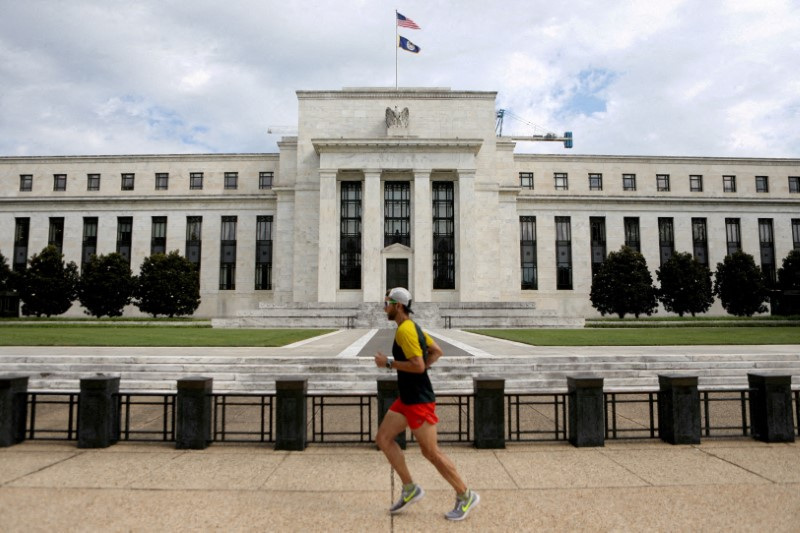By Mike Dolan
LONDON (Reuters) -The Federal Reserve's road ahead appeared crystal clear in September, but the picture is far foggier than many thought and the past and future impact of immigration on the labour market is hardest to see through.
Less than a month ago, the Fed launched its easing campaign with a jumbo half-point interest rate cut, sounding confident inflation had largely been licked and the red-hot jobs market was cooling.
But a combination of forecast-busting payrolls gains last month, an unexpected drop in the unemployment rate and stickier consumer prices has seemingly shifted Fed rhetoric back into more wait-and-see territory.
The release on Wednesday of minutes from last month's Fed meeting revealed far less certainty about prevailing economic conditions and the official data reflecting them than the statement issued on the day of the decision.
"Many participants", the minutes recorded, "observed that the evaluation of labor market developments had been challenging, with increased immigration, revisions to reported payroll data, and possible changes in the underlying growth rate of productivity cited as complicating factors".
And the formal readout added that "several participants" emphasised the importance of continuing to use "disaggregated data or information provided by business contacts as a check on readings on labor market conditions".
The Fed may not be flying blind, but it's still desperately trying to filter many of the critical signals on its dashboard.
Reflecting some of those multiple data twists, Atlanta Fed President Raphael Bostic told the Wall Street Journal on Thursday: "This choppiness to me is along the lines of maybe we should take a pause in November. I'm definitely open to that."
JUNE SWITCH
A large part of the confusion on U.S. economic and employment resilience surrounds on huge revisions to post-pandemic immigration numbers that lifted workforce projections, eased labour shortages and arguably cooled wage and price growth.
But that picture is morphing yet again with mid-year changes to migration policies and a post-election stance that's up in the air.
Most economists' thinking on immigration was jarred in February when revisions by the U.S. Congressional Budget Office (CBO) showed there were 3.3 million net immigrants last year compared to the 1 million projected pre-pandemic.
For many economists, that went some way to explaining the surprising strength of the U.S. labour market, consumer spending and overall growth since 2022, even as the Fed was tightening credit conditions.
After reconfiguring its forecasts, the CBO said this surge in net immigration could increase the U.S. workforce by 5.2 million over the next 10 years. The organisation projects this could add some $7 trillion to economic output and $1 trillion to tax revenue.
These revised forecasts, in turn, prompted some private sector economists to begin arguing that the labour market could run hotter than previously expected without generating fresh inflation. That led many to estimate that sustainable monthly payroll growth could be as high as 200,000 through year-end.
But the picture was complicated again in June when the U.S. immigration stance shifted. President Joe Biden announced two major policy moves: an asylum ban to cut illegal crossings at the U.S.-Mexico border and sweeping measures to legalise many long-term residents married to U.S. citizens.
Economists at Barclays estimate the combination of Biden's move, reduced numbers of would-be immigrants at the southwest border, and a suspension of an advance parole programme for Cuba, Venezuela, Haiti and Nicaragua has reduced flows of entrants sharply.
They now estimate that so-called "humanitarian" net immigration, which accounts for people who need protection but are not refugees, is stabilising at only around 100,000 per month compared to as many as 300,000 late last year.
That would add an estimated 63,000 to the labour force each month going forward. That's much lower than the level over the past 18 months.
To make things even more complex, delays in work registrations mean those who arrived before June's policy move may buoy payrolls to the end of 2024 and will possibly be reflected in September's jobs report.
DISTORTIONS AND DEPORTATIONS
So far, so uncertain - and that's even before attempting to dissect the statistical contortions involved in assumptions about overall population size, the share of U.S.-born citizens expected to join the labor force, and related effects on the household survey used to compile the unemployment rate at large.
What's more, payrolls data is likely to be distorted over the next month due to recent strikes and devastating hurricanes.
And then there's what could be the biggest game-changer of all: the U.S. presidential election next month. Former President Donald Trump's draconian proposals on migration are obviously a clear break with existing policies and those put forward by Democrat candidate Kamala Harris.
Not only has Trump detailed numerous plans to limit immigration, he has pledged to launch the largest deportation effort in U.S. history.

Considering all of this and the significant impact immigration can have on so many aspects of the economy, it's little surprise the Fed is having some trouble seeing the path ahead.
The opinions expressed here are those of the author, a columnist for Reuters
(By Mike Dolan; Editing by Jamie Freed)